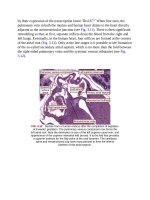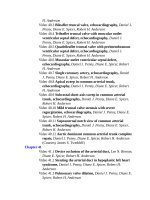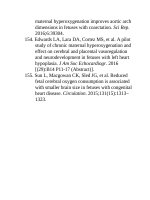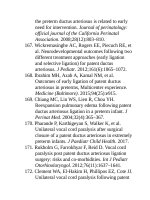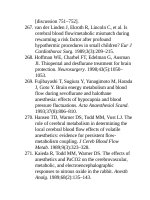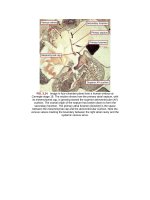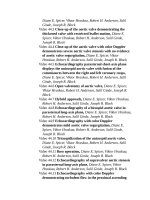Andersons pediatric cardiology 1081
Bạn đang xem bản rút gọn của tài liệu. Xem và tải ngay bản đầy đủ của tài liệu tại đây (181.34 KB, 3 trang )
FIG.41.8 Variationinsizeofthepersistentlypatentarterialduct(doubleheadedarrows).(A)Relativelynarrowlumenofthechannel.(B)Wide
lumenofthechannel.
Theductcanalsovaryconsiderablyinitsshape.Studyofalargenumberof
angiogramsfrompatientswithpersistentlypatentductsundergoing
interventionalclosureattheHospitalforSickChildren,Toronto,40showedthat
themostfrequentpatternwastofindaconstrictionatthepulmonaryendofthe
duct.Thispatternwasseenintwo-thirdsofcases.Injustlessthan20%,a
constrictionwasfoundattheaorticendoftheduct,andinjustlessthan10%the
lumenwasunrestricted.Injustlessthan5%,therewasaconstrictionatboth
ends,andtheremainingpatientsshowedbizarrepatternsnotlendingthemselves
toclassification(Fig.41.9).Uniquetotheprematureinfant,theductiselongated
andunrestrictive,withaslightcranialangulationfollowedbyacaudalturnasit
connectstothepulmonaryartery.41
FIG.41.9 Variationinmorphologyofthearterialductnotedfrom
angiogramstakenpriortointerventionalclosure.
Inthepast,persistentlypatentarterialductswereoftenthenidusforinfectious
endocarditis,butthiscomplicationisnowextremelyrareindevelopedcountries.
Ductscouldalsobecomeaneurysmalandelongated(Fig.41.10),butthisisalso
nowararefinding,asisductalrupture.
FIG.41.10 Lateralangiogramofachildwithanelongatedducttaken
beforetranscatheterocclusion.
